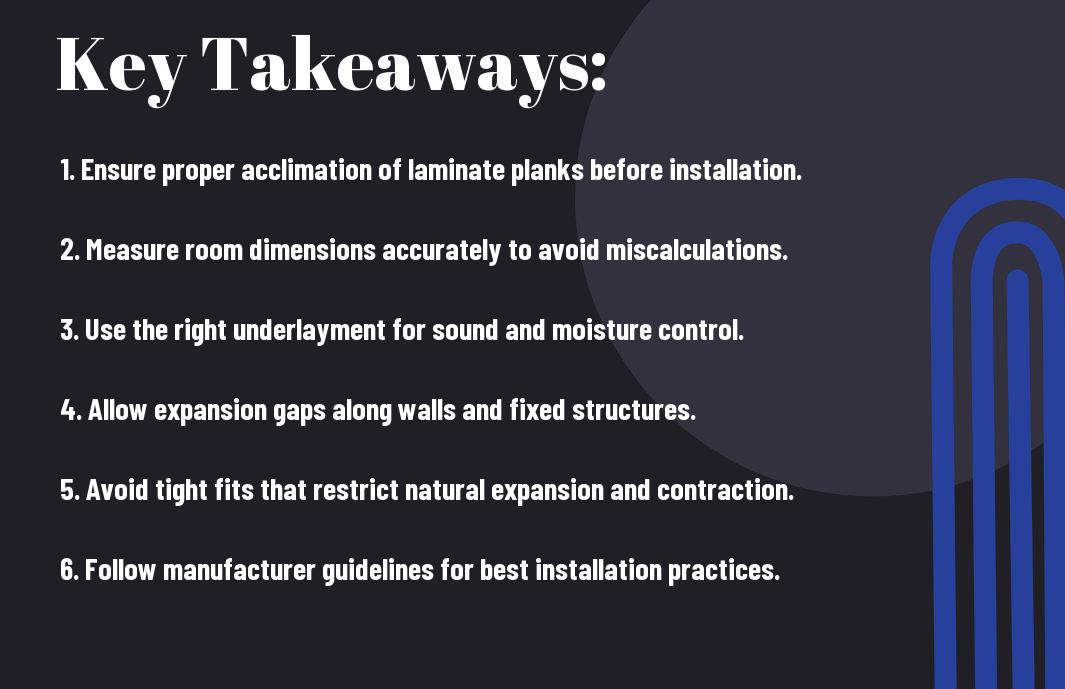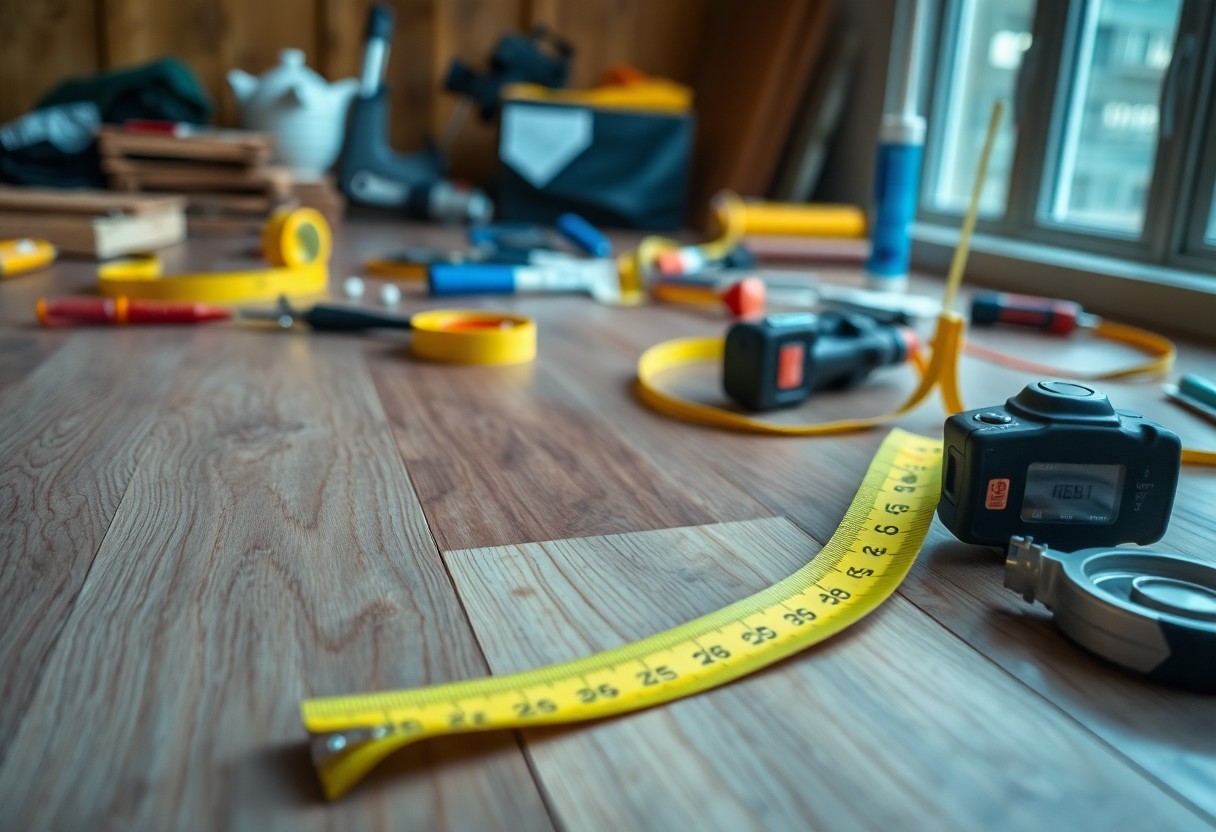With the right preparation and knowledge, you can achieve a beautiful laminate floor that enhances your space. However, many homeowners make common mistakes during installation that can lead to costly issues down the line. This post will guide you through these pitfalls and provide practical tips to ensure your laminate flooring project goes smoothly, resulting in a durable and visually appealing finish. Let’s investigate into what you should avoid to achieve the best results for your flooring project.

Proper Planning
Before you begin installing laminate flooring, proper planning is crucial for a successful outcome. This involves not only gathering the right tools and materials but also being aware of your timeline and the specific needs of your space. Take the time to assess your project thoroughly, as a well-thought-out plan can save you time and prevent costly mistakes during installation.
Measuring the Space
Around your space, accurate measurements are vital. Ensure you measure the length and width of the area where you’ll be installing laminate flooring. This will help you determine how much flooring you will need and minimize waste. Double-check your measurements, as even a small error can lead to complications during installation.
Acclimating the Flooring
On the other hand, acclimating your laminate flooring is an important step that should not be overlooked. This process allows the flooring to adjust to the temperature and humidity of your home, preventing issues like warping or buckling after installation.
It is advisable to leave your laminate flooring planks in the room where they will be installed for at least 48 hours before you start laying them down. During this time, keep the planks in their original packaging and lay them flat to avoid bending. This adjustment period helps ensure that your flooring performs optimally and retains its appearance over time, further enhancing the beauty and longevity of your investment.
Choosing the Right Underlayment
Any laminate flooring installation can be improved with the right underlayment. This material acts as a barrier between your floor and the subfloor, providing insulation, sound absorption, and moisture protection. Selecting the appropriate underlayment not only enhances the performance of your laminate floor but also extends its lifespan, ensuring you enjoy your investment for years to come.
Types of Underlayment
Between the various options, you should consider what best suits your needs:
- Foam underlayment
- Felt underlayment
- Rubber underlayment
- Combination underlayment
- Engineered underlayment
The right type of underlayment can make a significant difference in your flooring experience.
Importance of Quality
Right from the start, the quality of underlayment you choose can significantly affect your flooring’s durability and performance. High-quality underlayment provides better moisture resistance, sound dampening, and thermal insulation, contributing to a more comfortable living space. Choosing a reliable product means fewer headaches later on with potential issues like warping or noise, allowing you to truly enjoy your laminate flooring.
Understanding the value of investing in quality underlayment cannot be overstated. A well-chosen underlayment supports your laminate floor, enhances its stability, and can actively prevent damage caused by moisture or sound transmission. When you prioritize quality, you create a solid foundation for your laminate flooring, ensuring that it not only looks great but also performs optimally throughout its life.
Installation Techniques
Many homeowners overlook the importance of proper installation techniques during laminate flooring installation. Ensuring you choose the right method for your floor will help prevent future issues like buckling or cracking. Start by familiarizing yourself with the specific installation guidelines provided by the manufacturer, as these can vary between products. Following these guidelines closely will ensure your laminate flooring looks great and lasts for years to come.
Expansion Gaps
After laying down your laminate flooring, it is necessary to leave appropriate expansion gaps around the perimeter of the room. These gaps, usually 1/4 inch to 1/2 inch, allow for the natural expansion and contraction of the laminate due to changes in temperature and humidity. Failing to incorporate these gaps may lead to excessive pressure on your floor, causing it to buckle over time.
Correct Locking Methods
After selecting the right laminate, you need to utilize the correct locking methods during installation. Each flooring product has its specific locking mechanisms that, when used properly, can enhance durability and performance. Make sure you fully engage the locking system as you lay the planks, ensuring they click into place securely.
Gaps or misaligned planks can arise if the locking methods are not followed, leading to a less stable floor. Avoid forcing pieces together; instead, align them carefully to ensure a snug fit. If you encounter resistance during installation, double-check the alignment and locking system instead of applying too much force, which can damage the boards and compromise their lifespan.

Tools and Equipment
Despite the simplicity that laminate flooring installation may seem to offer, using the right tools and equipment is vital for achieving professional results. A common oversight is assuming that you can make do without certain tools or that household items will suffice. Investing in quality tools not only makes the installation process smoother but also enhances the longevity of your flooring. Having the correct equipment at hand ensures that you can tackle the job efficiently and effectively.
Essential Tools
Across various installation projects, certain tools are deemed crucial for a successful laminate flooring installation. These include a tapping block, pull bar, saw (circular or miter), measuring tape, and a level. Having these tools ready will facilitate a seamless installation process and reduce the chances of mistakes. It’s helpful to familiarize yourself with each tool’s function to ensure optimal use throughout your project.
Common Misuses
Common mistakes often arise from the improper use of tools, leading to inefficiencies and potential damage to your laminate flooring.
To avoid these pitfalls, ensure you fully understand how to use each tool correctly. For example, using a tapping block incorrectly can result in chipping or damaging the edges of your laminate planks. Similarly, neglecting to measure twice before cutting can lead to wasted materials and uneven seams. Familiarizing yourself with each tool’s purpose and applying best practices will empower you to execute the installation with confidence and precision.
Managing Waste and Cuts
Keep your workspace organized to minimize waste during laminate flooring installation. Planning your cuts and managing the leftover pieces effectively can save you time and money. Ensure you have a designated waste area and promptly discard unusable materials to maintain a clean and efficient worksite.
Efficient Cuts for Layout
Behind every successful flooring project lies a well-planned layout that maximizes material usage. Before making any cuts, take the time to measure your space accurately and sketch out a layout. This will not only help streamline the cutting process but also ensure that you utilize the planks effectively without incurring unnecessary waste.
Avoiding Waste
Among the key aspects of laminate flooring installation is minimizing waste during the cutting process. By making strategic cuts and planning your layout well, you can effectively use the remnants of your flooring planks for future projects or repairs, reducing overall waste.
And one effective way to avoid waste is by utilizing the offcuts wisely. Consider larger cuts for high-visibility areas for a clean finish and save smaller pieces for areas that are less noticeable or for transitions. You can also use leftover pieces in closets or storage spaces, ensuring that every inch of your laminate flooring contributes to your overall project, ultimately adding value to your investment.
Post-Installation Care
Once again, proper care following your laminate flooring installation is crucial to ensure its longevity and aesthetics. After the hard work of laying down your new flooring, taking a few simple steps can help maintain its beauty and functionality. By focusing on timely cleaning and ongoing maintenance, you can protect your investment and enjoy your new floor for years to come.
Immediate Cleaning
Post-installation, it’s vital to clean your laminate flooring with care. Start by removing any debris or dust created during the installation process. Use a soft-bristle broom or a vacuum specifically designed for hard floors to avoid scratches. It’s best to avoid any wet cleaning methods at this stage, as excess moisture can damage laminate.
Long-Term Maintenance
At the outset of maintaining your laminate flooring, focus on regular cleaning and protection strategies. Ensure that you vacuum or sweep weekly to eliminate dirt and debris that can scratch the surface. Use a damp microfiber mop with a gentle cleaner recommended for laminate floors to keep it looking pristine. Additionally, placing mats at entryways can help reduce wear and tear.
The key to long-term maintenance lies in your daily routines and mindful practices. Avoid using excessive water or harsh chemicals while cleaning, as these can lead to damage over time. Regularly inspecting for signs of wear or water damage will help catch issues early. With a commitment to a consistent cleaning schedule and protective measures, your laminate flooring will remain in great shape for years to come.
Summing up
Presently, avoiding common mistakes during your laminate flooring installation can significantly enhance the outcome and longevity of your floors. Ensure that you acclimate the laminate properly, maintain an even subfloor, and leave adequate expansion gaps. Additionally, using the right tools and following the manufacturer’s guidelines will promote a flawless finish. By being mindful of these potential pitfalls, you can enjoy a beautiful and durable laminate floor that enhances your space.

